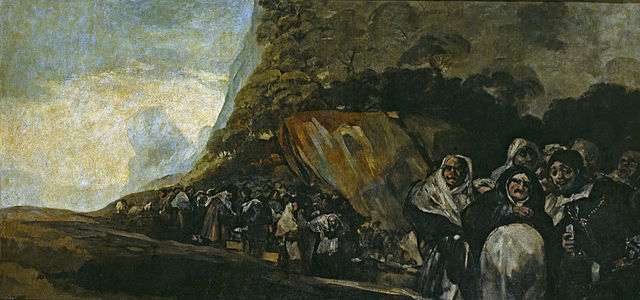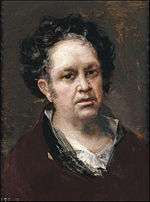Black Paintings
_crop.jpg)
The Black Paintings (Spanish: Pinturas negras) is the name given to a group of fourteen paintings by Francisco Goya from the later years of his life, likely between 1819 and 1823. They portray intense, haunting themes, reflective of both his fear of insanity and his bleak outlook on humanity. In 1819, at the age of 72, Goya moved into a two-story house outside Madrid that was called Quinta del Sordo (Deaf Man's Villa). Although the house had been named after the previous owner, who was deaf, Goya too was nearly deaf at the time as a result of an illness he had suffered when he was 46. The paintings originally were painted as murals on the walls of the house, later being "hacked off the walls and attached to canvas."[1] Currently they are held in the Museo del Prado in Madrid.
After the Napoleonic Wars and the internal turmoil of the changing Spanish government, Goya developed an embittered attitude toward mankind. He had a first-hand and acute awareness of panic, terror, fear and hysteria. He had survived two near-fatal illnesses, and grew increasingly anxious and impatient in fear of relapse. The combination of these factors is thought to have led to his production of the fourteen works known collectively as the Black Paintings.
Using oil paints and working directly on the walls of his dining and sitting rooms, Goya created works with dark, disturbing themes. The paintings were not commissioned and were not meant to leave his home. It is likely that the artist never intended the works for public exhibition: "...these paintings are as close to being hermetically private as any that have ever been produced in the history of Western art."[2]
Goya did not give titles to the paintings, or if he did, he never revealed them. Most names used for them are designations employed by art historians.[3] Initially, they were catalogued in 1828 by Goya’s friend, Antonio Brugada.[4] The series is made up of the following pictures: Atropos (The Fates) (Átropos/Las Parcas), Two Old Men (Dos viejos/Un viejo y un fraile), Two Old Men Eating Soup (Dos viejos comiendo sopa), Fight with Cudgels (Duelo a garrotazos/La riña), Witches' Sabbath (Aquelarre/El Gran Cabrón), Men Reading (Hombres leyendo), Judith and Holofernes (Judith y Holofernes), A Pilgrimage to San Isidro (La romería de San Isidro), Women Laughing (Mujeres riendo), Procession of the Holy Office (Peregrinación a la fuente de San Isidro/Procesión del Santo Oficio), The Dog (Perro semihundido/El perro), Saturn Devouring His Son (Saturno devorando a un hijo), La Leocadia (Una manola: doña Leocadia Zorrilla), and Fantastic Vision (Visión fantástica/Asmodea).
Images of the Black Paintings
|
|
|
History of the Black Paintings
In 1823 Goya ceded the house, along with the murals, to his grandson Mariano Goya, probably to protect the house from possible reprisals after the restoration of absolute monarchy and repression of liberals by supporters of Fernando VII of Spain. The paintings were little known for half a century. Only certain art critics, such as Charles Yriarte, wrote about them.[5]
The slow process of transferring the murals onto canvas began in 1874. It was carried out under the supervision of Salvador Martínez Cubells at the request of Baron Émile d’Erlanger,[6] a French banker of German origins, who wanted to sell them at the Paris World’s Fair in 1878. However, in 1881 the baron donated the paintings to the Spanish state and they are now on display at the Museo del Prado.[7]
The Black Paintings in their original setting

Goya acquired the villa on the banks of the River Manzanares, near the Segovia bridge and with views over the plains of San Isidro, in February 1819. It has been suggested that he bought the house to escape public attention; he lived there with Leocadia Weiss, even though she was still married to Isidoro Weiss. It is thought that Goya had a relationship with her and possibly a daughter, Rosario. It is not known exactly when Goya began painting the Black Paintings. It is possible that he started work on the murals between February and November 1819 when he fell seriously ill as testified by the disturbing Self-portrait with Dr Arrieta (1820). What is known is that the murals were painted over rural scenes containing small figures as Goya made use of the landscapes in some of his murals such as Fight with Cudgels.

If the light-toned bucolic paintings are also the works of Goya, it may be that his illness and the turbulent events of the Trienio Liberal led him to paint over them.[9] Bozal has suggested that those paintings also were painted by Goya as this is the only way to understand why he reused them. However, Nigel Glendinning assumes that the paintings "already adorned the walls of Quinta del Sordo when he bought it."[10] Whatever the truth of the matter, the Black Paintings murals probably date from 1820 and were likely finished no later than 1823 when Goya, departing for Bordeaux, left the villa to his grandson Mariano,[11] perhaps due to fear of reprisals after the fall of Rafael Riego and the republican army. Mariano de Goya transferred ownership of the villa to his father Javier de Goya in 1830.
A recent theory has attributed the authorship of the paintings to Javier de Goya, the painter’s son. Bozal and Glendinning, two of the greatest experts on Goya’s work, reject this hypothesis, however.[12] It is difficult to imagine that Goya’s contemporaries were unaware of this extraordinary act of creativity. The painting technique, the quality of the brushwork, the grotesque human figures and the obsessive themes that were already present in Goya's work give little reason to believe that the work could be attributed to Javier de Goya.
Antonio Brugada’s inventory mentions seven murals on the ground floor and eight on the top floor. However, only fourteen paintings arrived at the Museo del Prado. Charles Yriarte also describes an additional painting to those currently known to be in the collection; he indicates that when he visited the villa in 1867, it had already been removed from the wall and taken to the Marquis of Salamanca’s Vista Alegre Palace. Many critics consider that because of its size and theme the missing painting must be the one identified as Heads in a landscape (New York, collection Stanley Moss).[13]
The other problem regarding the location of paintings revolves around the painting called Two Old Men Eating Soup; there is uncertainty whether it was painted on a lintel in the upper or lower floor. Leaving this aside, the original distribution of the murals in Quinta del Sordo was the following:[14]
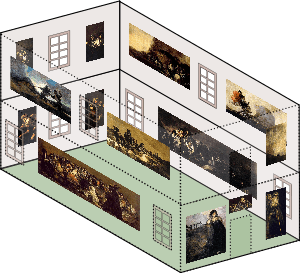
- Ground floor: It is a rectangular space. On the two long sides there were two windows near the shorter walls. Between these windows, there were two large murals in the form of landscapes: A Pilgrimage to San Isidro on the right when facing the murals and Witches' Sabbath on the left. At the back, on the smaller wall opposite the entrance, there was a window in the centre with Judith and Holofernes on the right and Saturn Devouring His Son on the left. La Leocadia was located on one side of the door (opposite Saturn) and Two Old Men was opposite Judith.
- First floor: It was the same size as the ground floor, although there was only one central window in the long walls with a mural on each side. The right-hand wall as one entered contained Fantastic Vision nearest to the entrance with Procession of the Holy Office beyond the window. On the left were Atropos (The Fates) and Fight with Cudgels respectively. On the short wall at the back it was possible to see Women Laughing on the right and Men Reading on the left. To the right of the door was The Dog and to the left Heads in a landscape.
Two Old Men Eating Soup would have been above one of the doors; Glendinning has suggested that it was above the door on the ground floor due to the design of the painted paper that appears in Laurent's photograph of the mural.
Information may be gained from written testimonies regarding the distribution and the original state of the murals and also from an in situ photographic inventory carried out by Jean Laurent in 1874.[15] The photographs were commissioned by Baron de Erlanger when he employed Martínez Cubells to transfer the paintings. Laurent’s photographs were an accurate representation of the process of transferring the murals to canvas. The art historians Gregorio Cruzada Villaamil and Charles Yriarte had been concerned for at least ten years that increases in property prices in the area would result in the redevelopment of the villa and the loss of the paintings.[16]
It is possible to see in Laurent's photographs that the murals were framed with borders painted in classicist design as were the doors, windows and the frieze above the door. The walls were papered as was the custom in bourgeois and aristocratic residences, possibly with wallpaper from the Royal Painted Paper Factory which was patronized by Fernando VII. The paper on the ground floor was decorated with motifs of fruit and leaves and the first floor was decorated with geometrical drawings organized in diagonal lines. The photographs also document the state of the drawings before they were moved, showing, for example, that a large part of the right-hand side of Witches’ Sabbath has not been conserved, although it was transferred to canvas by Martínez Cubells.[17]
 Photograph of Witches’ Sabbath taken in 1874 by J. Laurent inside Quinta del Sordo. Photo-library of the SCHI. |
 Witches’ Sabbath in its present form with cut edges |
Contextual analysis
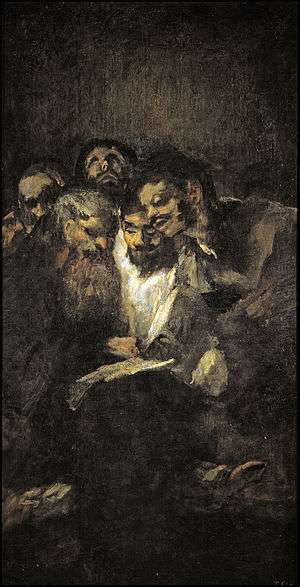
Perhaps the best known of the Black Paintings is Saturn Devouring His Son. The image portrays the Titan Kronos (or Saturn in Roman mythology), father of Zeus, eating one of his children. Fearing a prophecy that one of his children would overthrow him, Saturn ate each of his children upon their birth. Goya depicts this act of cannibalism with startling savagery. The background is black while the limbs and head of Saturn seem to pop out of the shadows. Saturn's eyes are huge and bulging as if he is mad. His fingers dig into the back of his child whose head and right arm are already consumed. Saturn is about to take another bite of the body's left arm. The only use of color beside fleshtones is the splash of red blood covering the mutilated outline of the upper part of the partially eaten, motionless body which is chillingly depicted in deathly white.
Another of Goya's works from the series is known as Witches' Sabbath or The Great He-Goat (El aquelarre). Ominous and gloomy, this earth-toned illustration depicts the ancient belief that the Sabbath was a meeting of witches supervised by the Devil who took the form of a goat. The goat is painted entirely in black and appears as a silhouette in front of a coven of witches and warlocks. They have sunken eyes and horrifying features, and appear huddled together, leaning towards the devil. Only one girl seems resistant to the crowd. She sits at the far right, dressed in black. Though she does not appear involved in the ritual, she does seem to be captivated by the group's relationship to the Devil.
Not all of the Black Paintings share the limited colours of the previous two examples. Fight with Cudgels shows Goya's dramatic use of different shades of blue and red as two men beat each other. While in the original version they were fighting on a meadow, the painting was damaged during the transfer and the version at the Prado has been painted over, stressing the eeriness of the fighters, unable to escape each other's blows due to their knee-deep entrapment in a quagmire. It has been taken as a premonition of the fight of the two Spains that would dominate the following decades. Fantastic Vision also uses bright red in the garb of one of the two giant figures hovering over a group of horsemen and also in the feather of the hat of a rifleman taking aim at these figures.
From 1820 onward his contemporaries increasingly valued Goya as he developed the Sturm und Drang style in his paintings. The ideas behind the Sturm und Drang movement were developed by Edmund Burke in his A Philosophical Enquiry into the Ideas of the Beautiful and Sublime (1757) and the influence of the movement extended throughout Europe during the second half of the eighteenth century. During the romantic period originality in an artist was valued above all else and authors such as Felipe de Guevara demonstrated the contemporary taste for work by saturnine artists whose melancholy led them to produce work full of "asperity and despair never before imagined."[10]
Art critics uniformly agree that certain psychological and social influences lay behind the creation of the Black Paintings. Among the former was the painter's awareness of physical decline, accentuated by his cohabitation with a far younger woman, Leocadia Weiss. Goya's serious illness of 1819 marks the beginning of this decline; it struck him down and left him weak and near to death. These preoccupations are reflected in Goya's use of colors and choice of subjects.
From a sociological point of view, everything suggests that Goya painted these murals after 1820 and after recovering from his illness, although there is no definitive proof of this. His satirical treatment of religion (pilgrimages, processions, the Inquisition) and civil confrontations (such as in Fight with Cudgels, or the visibly conspiratorial meetings that appear in Men reading; or even taking into account the political interpretation that may be applied to Saturn: the state devouring its subjects or citizens) is concordant with the unstable position that Spain found itself in following the constitutional uprising led by Fernando Riego. In fact, the period when Spain was governed by a liberal government (the Trienio Liberal which lasted from 1820-1823) coincided with the creation of the murals. It must therefore be considered likely that the themes and tone of the paintings were made possible by the absence of political censure which increased again with the restoration of absolute monarchy. On the other hand, many of the characters in the Black Paintings (duelers, frail old men, nuns, spies and informers of the Inquisition) represent a world that was rendered obsolete by the French Revolution.
Themes
Despite a number of attempts, no overarching interpretation of the series in its original context has been widely accepted. This is partly because exact layout of the murals is still subject to conjecture but it is mainly because of the ambiguity and the difficulty of finding the exact meaning of many of the paintings. This has meant that the overall significance of the paintings remains an enigma. Having said this there are a number of interpretations that are worthy of consideration.
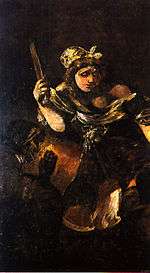
Glendinning has suggested that Goya decorated his villa in accordance with the décor that is found in the palaces of the nobility and homes of the upper middle classes. According to these rules, and taking into consideration that the ground floor was used as a dining room, the theme of the paintings should accord with their surroundings. This means that the paintings should be country scenes (the villa was situated on the banks of the River Manzanares opposite the San Isidro plain) and still life paintings and representations of banquets that allude to the room's function. Although Goya did not explicitly deal with these themes Saturn Devouring His Son and Two Old Men Eating Soup represent the act of eating, even if in an ironic way using black humour. In addition Judith killed Holofernes after inviting him to a banquet. Other paintings invert the traditional bucolic scene and are related to the nearby hermitage dedicated to the patron saint of Madrid: A Pilgrimage to San Isidro, Procession of the Holy Office and even Leocadia, whose sepulchre could relate to the cemetery near to the hermitage.
Seen from another point of view, the ground floor was poorly lit and most of the paintings it contained had dark backgrounds (with the exception of Leocadia where the main figure is seen dressed in black and is standing next to what may be a tomb, possibly Goya's). Therefore, the presence of death is felt strongly as is the approach of old age. A loss of sexual potency is also present, according to Freudian interpretation through the relationship with young women who will outlive and even castrate older men (Leocadia and Judith respectively). The old men eating soup, the other two “old men” in the eponymous painting and the aged Saturn all represent the masculine figure. Saturn is also the god of time and the incarnation of melancholy, related to the black bile, which nowadays we call depression.
On the first floor, Glendinning highlights the contrast between laughter and tears (satire and tragedy) and between earthly elements and those of the air. The first dichotomy is represented by Men Reading with its serious atmosphere, which is opposed by Women Laughing. These are the only two dark paintings in the room and they represent the model against which the other murals are measured, as they are the paintings that first become visible when a person enters the room. In the same way, the mythological scenes of Fantastic Vision and The Fates represent tragedy, while the other paintings such as Procession of the Holy Office provide a glimpse of a satirical scene. As regards the second of the contrasts, there are figures suspended in the air in the two previously mentioned paintings and others buried or seemingly rooted in the ground as in Duel with Cudgels, Holy Office or Dog. However, none of these hypotheses satisfactorily solve the puzzle regarding a unifying theme for the paintings.
Style


The only unifying constant among all the paintings are the stylistic elements. The composition of these paintings is very innovative. The figures usually appear off-center, with the most obvious example of this being Heads in a Landscape where five heads cluster in the lower right-hand corner of the painting seemingly cut-off or about to leave the frame. This lack of balance demonstrates a very modern compositional style. Other paintings where the figures are to one side include A Pilgrimage to San Isidro where the main group is off center to the left, Procession of the Holy Office where the main group is to the right and even The Dog where empty space occupies the majority of the vertical space, leaving a small area below for the slope and the semi-submerged head. The composition is also lop-sided in The Fates, Fantastic Vision and even the original of Witches’ Sabbath, although the unevenness was lost when the painting was cut after 1875, even though the painting was removed whole.
Many of the scenes depicted in the Black Paintings are nocturnal, demonstrating the absence of light, the day that died. This is true of A Pilgrimage to San Isidro, Witches' Sabbath and Pilgrimage of the Holy Office (an afternoon retreating into sunset) where black backgrounds highlight the relationship with the death of the light. All of this generates a feeling of pessimism, of terrible visions, of enigma and unreal space.
People’s faces present reflective or ecstatic attitudes. The figures in the latter condition have their eyes open wider and their pupils surrounded by white; their mouths agape, their faces are caricatures, animalistic and grotesque. We are faced with the digestive tract, something disowned by academic norms. Goya shows us the ugly, the terrible; there is no beauty in art, only “pathos” and a certain intention to display all aspects of human life, including those aspects that make us feel uncomfortable. Bozal, not in vain, has called it the secular Sistine Chapel where salvation and beauty have been substituted by lucidity and an awareness of solitude, old age and death.
The chromatic range of the Black Paintings is limited to ocher, gold, brown, grey and black. Only the occasional white shines from clothes to give contrast or the rare stroke of blue from the sky or green from a landscape.
All these features are a demonstration of the characteristics that are currently considered to be the precursors of pictorial expressionism. This is because Goya’s work is coherent, especially in the way that art critics have appreciated it, and because of the impact that it has had on modern painting. It can be said that in this series Goya went further than ever in realizing his revolutionary ideas and innovative approach to pictorial art.
Refuted theories
While it is commonly believed that the Black Paintings are Goya's works, art professor Juan José Junquera has questioned their authenticity. After carrying out research on the Black Paintings in order to write his eponymous book, he concluded that "These are fake paintings". One of Junquera's main arguments is that the Quinta del Sordo villa had only one storey during the time Goya lived in the house. According to the professor, Goya's purchase contract for the Quinta, the deed of transfer to his only grandchild, Mariano, and a document relating to the property at the time of Mariano's marriage in 1830 describe a house with only one floor. The second storey was added after Goya's death, according to Junquera's research: "If the upper floors did not exist in Goya's time, of course they (the Black Paintings) are not by Goya." Junquera also states that there is no testimony by Goya's contemporaries concerning the Black Paintings. His hypothesis is that Goya’s son Javier, who had full access to the villa and knowledge of the master’s œuvre and technique, created the paintings. Javier’s son Mariano, who is described as a profligate, possibly passed them off as Goya’s or maybe Javier himself used the paintings (even if he did not paint them) to fetch a higher price for the house. Manuela Mena, the senior curator of 18th-century painting at the Museo National del Prado, speaking of this issue, has commented: "We cannot send The Dog to the museum basement because it was on the apparently non-existing second floor of the Quinta."[1]
Notes
- 1 2 New York Times, "The Secret of the Black Paintings," July 27, 2003
- ↑ Licht, 159
- ↑ Licht, 168
- ↑ There have been a number of suggestions for the names of these paintings. The earliest came from the inventory of the painter’s assets made by Antonio Brugada after Goya’s death.
After Goya’s death Antonio Brugada had carried out an inventory of these paintings and he had suggested a series of names for each one, names that, in some cases, were later supplemented or changed by specialized critics.
— Museo del Prado, on-line educational series «Mirar un cuadro»: El aquelarre (in Spanish). Archived September 11, 2007, at the Wayback Machine. - ↑ Charles Yriarte, Goya, sa vie, son oeuvre (1867).
- ↑ Cfr. Valeriano Bozal (2005), vol. 2, page 247:
Salvador Martínez Cubells (1842–1914), curator at the Museo del Prado and academician at the Royal Academy of Fine Art at San Fernando, transferred the paintings to canvas on behalf of the person who at that time, 1873, was owner of the villa, Baron Fréderic Emile d'Erlanger (1832-1911). The work was undertaken by Martínez Cubells with the help of his two brothers Enrique and Francisco (...)
— Valeriano Bozal, Francisco Goya, vida y obra (2 vols.), Madrid, Tf. Editores, 2005, vol. 2, page 247, ISBN 84-96209-39-3. - ↑ Museo Nacional del Prado: Enciclopedia On-Line (Spanish language), viewed 9 May 2009.
- ↑ "La Quinta de Goya", magazine Descubrir el Arte, nº 201, November 2015, pp. 18-24. ISSN 1578-9047
- ↑ Valeriano Bozal (2005), vol. 2, pages 248-249.
- 1 2 Glendinning (1993), page 116.
- ↑ Arnaiz (1996), page 19.
- ↑ Nigel Glendinning, "Las Pinturas Negras de Goya y la Quinta del Sordo. Precisiones sobre las teorías de Juan José Junquera", Archivo Español de Arte, July–September 2004, volume LXXVII, number 307, pp. 233 to 245.
- ↑ Heads in a landscape with commentary in Spanish. Archived February 3, 2012, at the Wayback Machine.
- ↑ There are on line virtual reconstructions of the space on: artarchive.com and theartwolf.com
- ↑ Carlos Teixidor, "Fotografías de Laurent en la Quinta de Goya", in the magazine Descubrir el Arte, nº 154, December 2011, pages 48-54.
- ↑ María del Carmen Torrecillas Fernández, «Las pinturas de la Quinta del Sordo fotografiadas por J. Laurent», Boletín del Museo del Prado, volume XIII, number 31, 1992, page 57 onwards.
- ↑ Newspaper El Globo, Madrid, 26 July 1875. Article titled: "Los frescos de Goya" (Goya’s frescos). The newspaper outlined the fact that Sr. Martínez Cubells had successfully transferred Witches’ Sabbath, which is also called "Asamblea de brujos y brujas" (Assembly of wizards and witches)(...),"a beautiful canvas of more than five metres in length". This quote proves that Martínez Cubells transferred the whole painting and that it was later cut, possibly so that it would fit into a restricted space in Paris.
Bibliography
- Arnaiz, José Manuel, Las pinturas negras de Goya, Madrid, Antiqvaria, 1996. ISBN 978-84-86508-45-6
- Benito Oterino, Agustín, La luz en la quinta del sordo: estudio de las formas y cotidianidad, Madrid, Universidad Complutense, 2002. Edición digital ISBN 84-669-1890-6
- Bozal, Valeriano, Francisco Goya, vida y obra, (2 vols.) Madrid, Tf., 2005. ISBN 84-96209-39-3.
- —, «Pinturas negras» de Goya, Tf. Editores, Madrid, Tf., 1997. ISBN 84-89162-75-1
- Ciofalo, John J. "Blackened Myths, Mirrors, and Memories". In: The Self-Portraits of Francisco Goya. Cambridge University Press, 2001.
- Connell, Evan S. Francisco Goya: A Life. New York: Counterpoint, 2004. ISBN 1-58243-307-0
- Cottom, Daniel. Unhuman culture. University of Pennsylvania, 2006. ISBN 0-8122-3956-3
- Glendinning, Nigel, «The Strange Translation of Goya's Black Paintings», The Burlingon Magazine, CXVII, 868, 1975.
- —, The Interpretation of Goya's Black Paintings, London, Queen Mary College, 1977.
- —, Goya y sus críticos, Madrid, Taurus, 1982.
- —, «Goya's Country House in Madrid. The Quinta del Sordo», Apollo, CXXIII, 288, 1986.
- —, Francisco de Goya, Madrid, Cuadernos de Historia 16 (col. «El arte y sus creadores», nº 30), 1993. D.L. 34276-1993
- Hagen, Rose-Marie y Rainer Hagen, Francisco de Goya, Colonia, Taschen, 2003. ISBN 3-8228-2296-5.
- Hughes, Robert. Goya. New York: Alfred A. Knopf, 2004. ISBN 0-394-58028-1
- Licht, Fred. Goya: The Origins of the Modern Temper in Art. Universe Books, 1979. ISBN 0-87663-294-0
- Stoichita, Victor & Coderch, Anna Maria. Goya: The Last Carnival. London: Reakton books, 1999. ISBN 1-86189-045-1
- Wilson-Bareau, Juliet. Goya's Prints, the Tomás Harris Collection in the British Museum. London: British Museum Publications, 1981. ISBN 0-7141-0789-1
- Yriarte, Charles, Goya, sa vie, son oeuvre, París, Henri Plon, 1867; translated into Spanish by Enrique Canfranc and Lourdes Lachén, Goya, Zaragoza, Departamento de Educación y Cultura, 1997. ISBN 84-7753-644-9.
External links
| Wikimedia Commons has media related to Black Paintings. |
- Francisco de Goya's "Black paintings" in the "Quinta del sordo"
- Blanca Flaquer (dir.), Valeriano Bozal (asesor), «Las pinturas negras, de Francisco de Goya» [vídeo en línea], La mitad invisible, www.rtve.es, 3 de enero de 2011, y 17 de marzo de 2012. Consulta: 25-03-2012.
- Visita virtual a la Quinta del Sordo.
- Catálogo de obras de Goya de la Universidad de Zaragoza en línea.
- «Pinturas negras», poema de Antonio Buero Vallejo.
- Black Paintings
- Valeriano Bozal, «Pinturas negras», Enciclopedia en línea, Museo del Prado, 2004-2008.

.jpg)



.jpg)
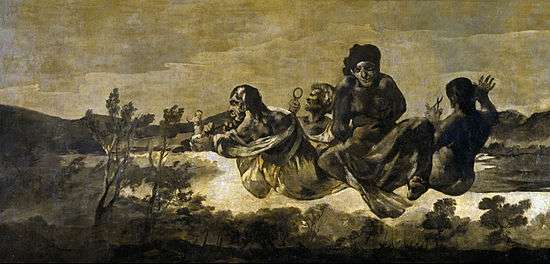
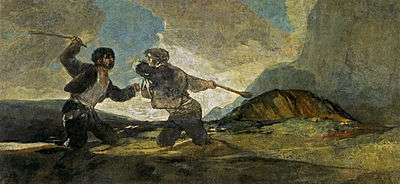

.jpg)
